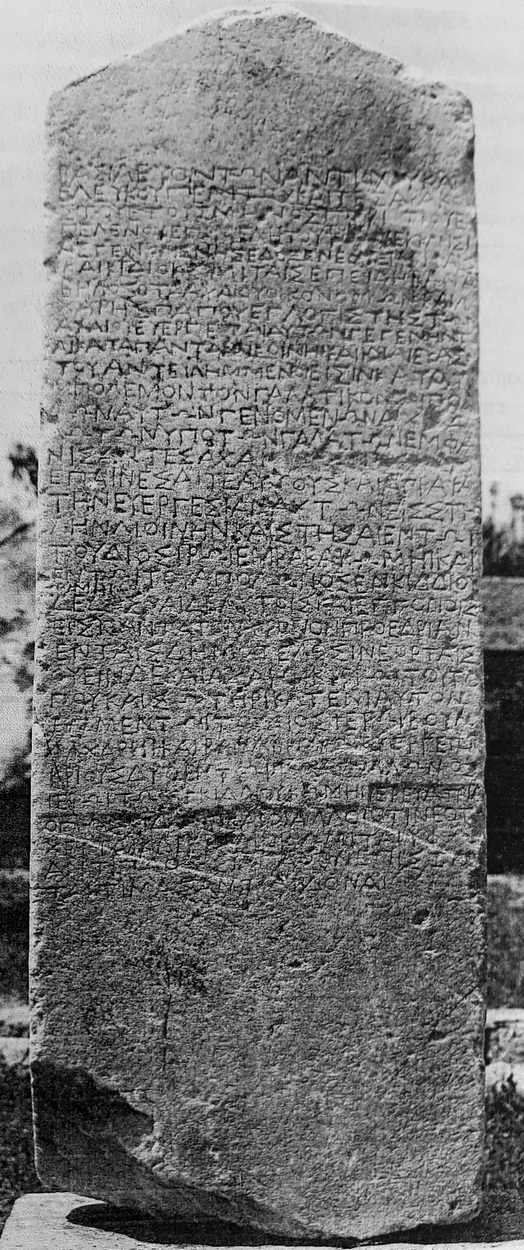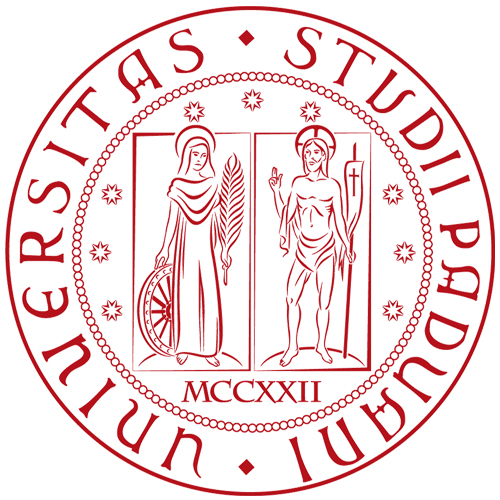
PHRC060 : Decree of the villages of Neon Teichos and Kiddiou Kome for Achaios and his collaborators (Lykos Valley) - Phrygia (267 BC) Decree
Permanent ID http://s.phrc.it/phrc060
Images
Photo 1: Photo of the stone, from IK Laodikeia am Lykos 1

Text constituted from: IK Laodikeia am Lykos 1.
Other editions: Wörrle 1975 ( SEG XLVII 1739); Bielman 1994, no. 23.
See also: CGRN 143 (consulted June 2021).
Images: Wörrle 1975, Tf. 17; IK Laodikeia am Lykos, p. 9.
Further bibliography: on the topography and history of the region in the 2nd quarter of the 3rd cent. BC, see Corsten in I.Laodikeia am Lykos 1; Schuler 1998, p. 187-189; Şimşek 2017, p. 3. On the historical context of the decree, see Bar-Kochva 1973; Wörrle 1975; Coşkun 2012, 2013, and 2021, p. 146-147. On Achaios, his status and estate, see also Billows 1995, p. 96-97; Capdetrey 2007, esp. p. 153-155, 262-263, 306-312; Chrubasik 2016, p. 70; McAuley 2018. On the hierarchy of cult recipients as expressed by the choice of sacrificial animals, see Caneva 2020c, p. 233.
Online record: PHI
βασιλευόντων
Ἀντιόχου καὶ
[Σ]
-
ελεύκου πέμτου καὶ τεσαρακο
-
στοῦ ἔτους, μηνὸς Περιτίου, ἐ
-
π’ Ἐλένου
ἐπιμελητοῦ \τοῦ/
τό[πο]υ·
ἐκκλησί
-
5ας γενομένης
ἔδοξε
Νεοτειχείταις
καὶ Κι\δ/διοκωμίταις·
ἐπειδὴ Βανά
-
βηλος ὁ τὰ Ἀχαιοῦ
οἰκονομῶν καὶ
Λα
-
χάρης Πάπου
ἐγλογιστὴς τῶν
Ἀχαιοῦ
εὐεργέται αὐτῶν γεγένηντ
-
10αι κατὰ πάντα
καὶ κοινῆι καὶ ἰδίαι ἑκάσ
-
του ἀντειλημμένοι εἰσὶν
κατὰ τ[ὸ]
-
μ πόλεμον τὸν Γαλατικὸν καὶ
πολ
-
λῶν αὐτῶν γενομένων
αἰχ[μ]α
-
λώτων ὑπὸ τῶν Γαλατῶν
ἐμφα
-
15νίσαντες
Ἀχαιῶ[ι]
ἐ[λυτ]ρώ[σα]ντο,
ἐπαινέσαι τε αὐτοὺς καὶ
ἀ\[ν]α/γράψαι
τὴν εὐεργεσίαν αὐτῶν εἰς
στή
-
λην λιθίνην καὶ
στῆσαι ἐν τῶι
τοῦ Διὸς
ἱ\ε/ρῶι
ἐμ Βάβα κώμηι καὶ
20ἐν τῶι τοῦ
Ἀπόλωνος
ἐμ Κιδδίου
\κώμηι/,
δεδόσθαι δὲ αὐτοῖς καὶ
ἐγγόνοις
εἰς πάντα τὸν χρόνον
προεδρίαν
ἐν ταῖς δημοτελέσιν
ἑορταῖς,
θύειν δὲ καὶ
Ἀχαιῶι
κυρίωι
τοῦ τό
-
25
που
καὶ σωτῆρι
κατ’ἐνιαυτὸν
ἐμ μὲν τῶι
τοῦ Διὸς ἱερῶι
βοῦν,
Λαχάρηι
καὶ Βαναβήλωι
εὐεργέται[ς]
κριοὺς
δύο
ἐν τῶι τ[οῦ Ἀ]πόλλωνος
ἱερῶι τῶι ἐγ
Κιδδίου κώμηι,
ἱερεῖα
τρία·
30
ὅπως
εἰδ[ῶ]σι
καὶ οἱ ἄλλοι,
ὅτι Νεοτ[ει]
-
χεῖται καὶ
Κι[δ]διοκωμῖται,
ὑφ’ ὧ[ν]
ἄν τι
πάθωσι ἀγαθ[ό]ν,
ἐπίσταν̣
-
ται τιμὰς ἀντιδιδόναι.
This marble stela contains a decree issued in 268/7 by the inhabitants of two villages in the Lykos valley (western Phrygia) to honour Achaios the Elder, a high-ranking Seleucid officer and the owner of an estate in the area, together with two of his collaborators, Banabelos and Lachares (on Achaios, see Corsten in IK Laodikeia am Lykos, p. 11-12 and McAuley 2018; on the two collaborators and the administration of the estate, see Corsten in IK Laodikeia am Lykos, p. 14, Bielman 1994, 92-93, Capdetrey 2007, 306-312). While Achaios never operated as a secessionist (Chrubasik 2016, p. 70), the degree of autonomy he enjoyed at the local level is noteworthy: King Antiochos I and his co-regent Seleukos are only mentioned in the dating formula (Seleukos will be sentenced to death in 267/266 as a consequence of a revolt against his father; cf. Just., Prol. 26; Joannes Antiochenus, FHG IV p. 558, F55), whereas only Achaios and his collaborators are deemed responsible and honoured for the protection of the region against the Galatians and for the liberation of the local prisoners. Moreover, in contrast to the more general meaning of the term Euergetes, which is used to honour Banabelos and Lachares, the epithet Soter granted to Achaios has a distinctive royal taste: not only was Soter only used of monarchs at this early chronology, but the attribution of the epithet in relation to the defence of the population against the Galatians is evocative of the similar explanation of Antiochos I’s title Soter (App., Syr. 65.343). The same can be said of the granting of ritual honours to non-royal recipients, in relation to which Achaios and his collaborators appear to us as the forerunners of a later phenomenon (cf. PHRC 062 for Olympichos at Mylasa). During the reign of Antiochos I (281-261 BC), Asia Minor faced the constant threat of raids made by aggressive Galatian tribes against cities and countryside settlements. The recent scholarship has convincingly replaced the common opinion of a major royal victory putting an end to this situation (the so-called and variously dated ‘elephant victory’, see Wörrle 1975) with the picture of an endemic state of war (Coşkun 2012, 2013, 2021, p. 146-147). The events mentioned in our decree should therefore be seen as a local episode in this long macro-regional struggle. On the other hand, the extension of this diffused conflict explains the augmented importance of regional administrators, who could contribute to the protection of the kingdom and therefore enjoy a growing prestige at court while also pursuing their own interests at the local level.
Various other details make this document an exceptional entry in our collection. To begin with, the text is a typical honorific decree, yet its institutional issuer was not a polis, but the villages of Neon Teichos and Kiddiou Kome, plausibly to be interpreted as a military garrison and a Phrygian settlement, respectively. Like various Seleucid cities of the period, this local community adopted the Seleucid era and the Macedonian calendar and had an assembly passing decrees, but there is no trace of a Council and the name of the eponymous magistrate, the epimeletes, is not that of a fully established city. There is no reference in the text to the city of Laodikeia on Lykos, a detail suggesting that the decree was passed in a period preceding the foundation of this polis, which was named after Antiochos II’s wife Queen Laodike (on the topography of the region and the relationship between the named settlements and the future territory of Laodikeia, see Corsten in IK Laodikeia am Lykos, p. 12-14; Schuler 1998, 187-189; Şimşek 2017, p. 3).
The clearly hierarchical treatment of the honours accorded to the three benefactors is another striking aspect of the decree. While Achaios and his collaborators all receive the right of prohedria on public festivals for themselves and their offspring, their internal hierarchy is expressed by the ritual honours granted by the two villages. Achaios shall annually receive the sacrifice of an ox, a major offering with regard to cost and prestige, in the sanctuary of Zeus at Baba Kome, whereas two rams will be offered to Banabelos and Lachares in the sanctuary of Apollo at Kiddiou Kome. The use of different sacrificial animals to express hierarchy between ritual recipients is well-attested in Greek polytheism but is an unicum in the documentation concerning cultic honours for political leaders (Caneva 2020c, p. 233). A similar way of shaping hierarchical relationships emerges from the choice of the cult places hosting these sacrifices. While nothing is known of the two sanctuaries, it is tempting to see the link with Zeus as a way to underscore Achaios’ higher status in relation to his collaborators, who are honoured in the sanctuary of Apollo. Finally, one can also observe that the chosen deities correspond to the major figures in the Seleucid royal pantheon. This detail strengthens the impression that the local community aimed at increasing the prestige of the honours accorded to their benefactors by adapting to them a set of ritual and ideological resources normally used to evoke the ruling house. The use of the epithet ‘Kyrios tou topou’ also seems to serve the same purpose. The term is not per se charged with a religious significance, but it is interesting to note that its use between Achaios’ name and the epithet Soter, in the dative indicating the recipient of the sacrificial offering, turns it into a ritual epiclesis encapsulating Achaios’ role as the proper owner, governor, and protector of the area.



